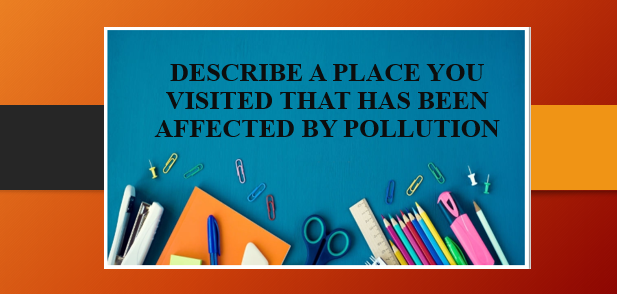Describe a place you visited that has been affected by pollution | Bài mẫu IELTS Speaking Part 2
Bài mẫu IELTS Speaking Part 2
Đề bài: Describe a place you visited that has been affected by pollution
You should say:
- Where it is
- When you visited this place
- What kinds of pollution you saw there And explain how this place was affected
Sample Speaking: Describe a place you visited that has been affected by pollution
Bài mẫu 1
Well, if I have to talk about a polluted place I’ve been to, it would be Ho Chi Minh City. It’s located in the Southern part of Vietnam.
I’ve been living here for around 2 years. When I first came here, I was so surprised how polluted the city is. It’s so different from my hometown which is a green and clean rural area. There are many kinds of pollution here: air pollution, water pollution and even noise pollution. There are so many vehicles on the streets and they make noises and emit fumes all the time. It was especially terrible travelling on the street during peak hours. Besides, it’s easy to see trash in rivers and lakes because some people just throw their waste into these community water sources without any awareness of the damage to the surrounding environment. It’s even worse that some factories also dump dirty water and other waste directly into rivers so many of them are black and smelly. I think the pollution affects people’s lives in a negative way.
Air pollution can cause serious respiratory diseases such as asthma or lung cancer. Water is polluted so people may face water scarcity in the future and the noise can drive people crazy because it’s really annoying and distracting. Many animals living in water are also affected, too. They are losing their habitats or food source since the water is contaminated. Some of them may become extinct if we do not take action now. I hope the government will have some kinds of campaigns or TV shows to raise people’s awareness of protecting the environment and plant more trees in the city to improve air quality.
Từ vựng trong bài:
-
Noise pollution /ˈnɔɪz pəˌluː.ʃən/: Ô nhiễm tiếng ồn
Noise /ˈnɔɪz/ : tiếng ồn
Pollution /pəˌluː.ʃən/ : Ô nhiễm
Ví dụ: An airport can generate noise pollution at most 24 hours in a given day.
-
Emit fumes: Xả khói
Emit /iˈmɪt/ : phát ra, xả
fumes /fjuːmz/ : khói
Ví dụ: Trolleybuses – a quiet form of public transport that was cheap and did not emit fumes – were also culled.
-
Peak hours /piːk/ /aʊər/: Giờ cao điểm
Ví dụ: The old bridge carries at peak hours about 12,000 vehicles a day.
-
Community water source: Nguồn nước công cộng
Community /kəˈmjuː.nə.ti/ : công cộng
water /ˈwɔː.tər/ : nước
source /sɔːs/ : Nguồn
Ví dụ: The outbreak highlighted the need for policies that would lead to improved community water sources and waste management throughout Kosovo.
-
Dump dirty water: Xả nước bẩn
Dump /dʌmp/ : đổ, xả
dirty /ˈdɜː.ti/ : Bẩn
Ví dụ: Waves were dumping more dirty water on the dirty beach.
-
Respiratory disease: Bệnh về đường hô hấp
Respiratory /rɪˈspɪr.ə.tər.i/ : hô hấp
disease /dɪˈziːz/ : Bệnh
Ví dụ: Respiratory disease in children represented 13% of deaths from household ambient pollution.
-
Asthma /ˈæs.mə/: Hen suyễn
Ví dụ: Also, the measure of asthma treatment is limited to self-report of having received treatment.
-
Lung cancer: Ung thư phổi
Lung /lʌŋ/ : phổi
cancer /ˈkæn.sər/ : Ung thư
Ví dụ: Lung cancer strongly linked to smoking
-
Water scarcity: Sự thiếu hụt nước
scarcity /ˈskeə.sə.ti/: sự khan hiếm, thiếu hụt
Ví dụ: Water scarcity and pollution are persistent global problems.
-
Drive someone crazy /draɪv/ /ˈsʌm.wʌn/ /ˈkreɪ.zi/: Khiến ai đó phát điên
Ví dụ: He leaves dirty clothes all over the floor and it's driving me crazy.
-
Take action /teɪk/ /ˈæk.ʃən/: Hành động (để giải quyết vấn đề)
Ví dụ: We must take action to deal with the problem before it spreads to other areas.
-
Improve air quality: Cải thiện chất lượng không khí
Improve /ɪmˈpruːv/ : Cải thiện
air /eər/ : không khí
quality /ˈkwɒl.ə.ti/ : chất lượng
Ví dụ: The US said it would share data and tools to help improve air quality.
Bài mẫu 2
One of the places that come to mind when talking about pollution would be Hanoi, I think. I went to Hanoi in late 2015 for business and stayed there for a couple of months in the winter. It’s definitely a nice city but the experience could be better, mostly because of the pollution that I experienced.
During the first morning that I was in the city, I went outside and there was a weird smog that covered the entire sky in grey. The whole day was dreary because of it and later, I noticed that it wasn’t the only day when that would happen. There were days when the weather was definitely sunny, because you could see sunlight on the street, yet when you looked up you could hardly see the sun. The smog completely shielded the sun from view, but I don’t think many people realized how serious that was, though.
The main method of transport in Hanoi is the motorbike and it’s probably one of the reasons why the city was so polluted. I used to travel by motorbike outside and because of that I was advised to wear a face mask to protect myself from all the dust and whatever particles in the air. But even though I wore a mask I could still feel the distinct smell of the fume that so many bikes were pumping into the environment through their exhaust pipes.
What was also striking was the river near the place that I stayed at. The water looked like a pitch blacksludge, and in fact, it was so black that I thought it was the city’s sewage line. The local folks told me that it was actually a river before getting polluted. It’s quite amazing actually that people managed to put up with this much pollution. But maybe if I had stayed longer, I would have learned to put up with it too.
Từ vựng trong bài:
- Could be better (v.): chưa tốt lắm (Cách dùng: N + could be better)
- Smog (n.): màn khói bụi
- Dreary (adj.): ảm đạm
- Shield (v.): che chắn trước thứ gì đó (Cách dùng: shield + Nh from + N2)
- Distinct (adj.): đặc trưng
- Pitch black (n.): màu đen như mực
- Sludge (n.): bùn nhớt
- Put up with (v.): chịu đựng điều gì đó (Cách dùng: put up with + N)
Bài mẫu 3
If I had to choose one polluted city close to my home, it would be the one closest to me, a small town in the North of China.
I just relocated here after being informed of my mandatory three-year employment commitment. When I initially arrived in this huge metropolis, I was taken away by the extreme degree of pollution present here. It’s a far cry from my hometown’s gorgeous, organized countryside back in the Midwest. Air pollution, water pollution, and noise pollution are just a few of the forms of pollution that have become endemic to this area. Numerous vehicles provide a constant stream of noise and pollutants.
Transportation at rush hour was fraught with danger. Further, some individuals carelessly dump their rubbish in rivers and lakes, therefore it is not hard to locate trash in these public water sources. One of the reasons why garbage is so prevalent in these waterways is because of this. Worse, some businesses are to blame for dumping dirty water and other forms of garbage into rivers, turning many of them into unsanitary cesspools. Pollution, in my view, has a negative impact on people’s day-to-day lives.
Several respiratory diseases, including asthma and lung cancer, have been linked to pollution. The degradation of water supplies can result in shortages in the future, and the incessant cacophony of traffic is enough to drive anyone nuts. Numerous aquatic organisms will be impacted. Since they can’t use the water for either drinking or farming, they risk losing their homes and food sources. There is a possibility that we may lose some of them for good if we do not act quickly. Luckily, the government will fund TV shows or other educational initiatives to raise public awareness about the need of environmental protection and increasing the amount of land covered by trees in urban areas.
Từ vựng:
- relocated [v]: di dời
- mandatory [adj]: sự bắt buộc/ràng buộc
- metropolis [n]: đô thị
- endemic [adj]: bệnh địa phương
- cesspools [n]: hầm cầu
- respiratory diseases [n]: bệnh hô hấp
- asthma [n]: bệnh hen suyễn
- lung cancer [n]: ung thư phổi
- degradation [n]: sự xuống cấp
- cacophony [n]: tạp âm
Bài mẫu IELTS Speaking Part 3
1. What are the differences between people living in the clean air and others?
In my view, there will be a great deal of difference between these two categories of individuals in many different ways. People who live in areas where there is a constant supply of clean air will never experience any discomfort and will be immune to diseases of the respiratory system. People who live or work in areas with high levels of air pollution are more likely to experience symptoms of discomfort brought on by the pollution, as well as an increased risk of developing diseases such as allergic rhinitis, asthma, and lung cancer. These individuals also find it difficult to breathe freely and must always wear a mask.
Dịch:
Theo quan điểm của tôi, sẽ có rất nhiều sự khác biệt giữa hai loại cá nhân này theo nhiều cách khác nhau. Những người sống ở những nơi có nguồn cung cấp không khí sạch liên tục sẽ không bao giờ cảm thấy khó chịu và sẽ miễn nhiễm với các bệnh về hệ hô hấp. Những người sống hoặc làm việc ở những khu vực có mức độ ô nhiễm không khí cao có nhiều khả năng gặp phải các triệu chứng khó chịu do ô nhiễm gây ra, cũng như tăng nguy cơ mắc các bệnh như viêm mũi dị ứng, hen suyễn và ung thư phổi. Những cá nhân này cũng cảm thấy khó thở tự do và luôn phải đeo khẩu trang.
2. What can individuals do to prevent air pollution?
People have a lot of power to keep the air they breathe healthy and clean. Reading this article is one of the most common ways that anybody may learn more and be more conscious about helping to promote the purity of the air, and it’s also one of the most popular ones. Utilizing power tools instead of those that generate hazardous pollutants, adopting electric and hydrogen-powered automobiles, and promoting carpooling and other kinds of shared mobility are all potential avenues to reduce air pollution. Since trees are the “capsules” that restore oxygen levels in the atmosphere, enhancing their aesthetic value is also very important.
Dịch:
Mọi người có rất nhiều quyền lực để giữ cho không khí mà họ hít thở trong lành và sạch sẽ. Đọc bài báo này là một trong những cách phổ biến nhất mà bất kỳ ai cũng có thể tìm hiểu thêm và ý thức hơn về việc giúp thúc đẩy sự trong sạch của không khí, và đây cũng là một trong những cách phổ biến nhất. Sử dụng các công cụ điện thay vì những công cụ tạo ra chất gây ô nhiễm nguy hiểm, sử dụng ô tô chạy bằng điện và hydro, đồng thời thúc đẩy việc đi chung xe và các hình thức di chuyển chung khác đều là những con đường tiềm năng có thể giúp giảm ô nhiễm không khí. Vì cây xanh là “viên nang” phục hồi nồng độ oxy trong khí quyển nên việc nâng cao giá trị thẩm mỹ của chúng cũng rất quan trọng.
3. Why are there places that have polluted air and there are places that don’t?
It is not easy to disentangle the lifestyle choices of city dwellers from the activities that contribute to air pollution. The common perception is that vehicles and other forms of mobility are significant causes of air pollution. However, development, heating, buildings, and transportation all contribute to making the issue worse. Air pollution is more severe in urban regions than in rural ones because of the higher population density and a more significant number of structures and cars. The more trees there are, the less pollution there will be, and the better life you may enjoy. Therefore, naturally, this will explain the significant variations in air pollution across various regions and nations.
Dịch:
Không dễ để phân biệt các lựa chọn lối sống của cư dân thành phố khỏi các hoạt động góp phần gây ô nhiễm không khí. Nhận thức phổ biến là xe cộ và các hình thức di chuyển khác là nguyên nhân chính gây ô nhiễm không khí. Tuy nhiên, sự phát triển, sưởi ấm, các tòa nhà và giao thông vận tải đều góp phần làm cho sự ô nhiễm trở nên tồi tệ hơn. Ô nhiễm không khí ở khu vực thành thị nghiêm trọng hơn so với khu vực nông thôn do mật độ dân số cao hơn và số lượng xe ô tô và công trình xây dựng nhiều hơn đáng kể. Càng có nhiều cây xanh, càng ít ô nhiễm và bạn càng có thể tận hưởng cuộc sống tốt hơn. Do đó, một cách tự nhiên, điều này sẽ giải thích sự khác biệt đáng kể về ô nhiễm không khí giữa các khu vực và quốc gia khác nhau.
Xem thêm các tài liệu Tiếng Anh hay, chi tiết khác:
TOP Việc làm "HOT" dành cho sinh viên:



